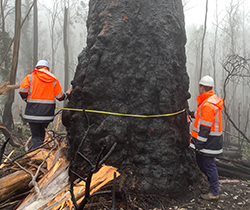EPA increases resources for forestry regulation
The EPA’s response to changing conditions in bushfire-affected areas of state forests shows how we are shifting our approach to regulating logging activities and adapting to risks and impacts to the environment and wildlife by the fires.

EPA operational officers carrying out forest inspections
The EPA is increasing its on-the-ground checks in native forests pre and post logging, to ensure protected areas are being conserved, using technology, data and intelligence to better inform its work and is working with the logging industry and the community.
The challenge of managing logging in landscapes so significantly impacted by fire means the EPA is increasing its operational, technical and legal resources for forestry regulation to increase the speed of on-ground deployment and timeliness of investigations.
The EPA has been working with Forestry Corporation of NSW (FCNSW) and the community to ensure controls put in place are implemented and effective.
The EPA has applied additional site-specific conditions to mitigate the specific environmental risks caused by the bushfires, which are tailored for the specific impacts on plants, animals and their habitats, soils and waterways at each site.
The additional conditions supplement the existing forestry rules, the Integrated Forestry Operations Approvals (IFOAs) to maximise the protection of unburnt or lightly burnt forest and limit harvesting intensity to assist with wildlife and biodiversity recovery efforts.
For example, in sites where koala habitat may be present, the site-specific operating conditions nearly double the amount of protections for koala feed trees and habitat. FCNSW is still required to check for the presence of koalas before any trees are felled and put in place temporary exclusion zones around areas where koalas are identified.
The EPA is now in discussions about how forestry operations are to be carried out going forward, as FCNSW are looking to return to harvesting under the standard Coastal IFOA without site-specific conditions.
In July, the EPA issued FCNSW with a Stop Work Order in South Brooman State Forest for allegedly breaching the site-specific conditions. The Stop Work Order was to remain in force for 40 days or until the EPA was confident that FCNSW could meet their obligations to comply with the IFOA and site-specific conditions.
At Wild Cattle Creek north of Coffs Harbour a Stop Work Order was also issued after it was alleged two giant trees had been illegally harvested.
The alleged breaches were identified by EPA operations officers conducting forest inspections while taking extra precautions to maintain social distancing and adhere to other important Covid-19 safeguards.
Executive Director Regional Operations Carmen Dwyer said the South Brooman Stop Work Order was the first issued by the EPA for alleged breaches of site-specific conditions.
“Failure to properly map and retain hollow bearing trees could result in irreparable environmental harm,” Carmen said.
The investigation into this particular matter is ongoing and non-compliance with the forestry rules, the Coastal IFOA, can attract a maximum penalty as high as $5 million.
The EPA uses a range of regulatory tools to achieve environmental compliance including formal warnings, official cautions, licence conditions, Stop Work Orders, notices, directions and prosecutions.

